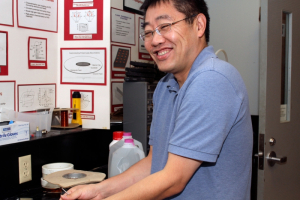Approximately 75 percent of the three million people worldwide with implanted pacemakers need magnetic resonance imaging, or MRI, in their lifetimes, and an estimated 500,000 of them live in the United States, Canada and Mexico. However, pacemakers, which control abnormal heart rhythms, limit access to the potentially lifesaving diagnostic technology because of electromagnetic interference.
Ji Chen, professor of electrical and computer engineering at the UH Cullen College of Engineering, is overcoming limitations for patients with pacemakers and other implanted medical devices with his electromagnetic compatibility research.
In 2014, the National Science Foundation awarded Chen, his UH collaborators and Missouri University of Science and Technology with their second five-year grant totaling $225,000 through the Industry/University Cooperative Research Centers program. The initial five-year $280,000 grant was awarded in 2009 to establish the Center for Electromagnetic Compatibility Research.
“The grant gives us credibility to attract industry partners,” Chen said. “We’re trying to build a one-stop shop, with all companies coming to the two universities for electromagnetic compatibility research.”
The center works with 25 industry partners who fund the majority of the research with annual membership dues that give their engineers access to two annual on-site meetings and weekly conference calls with university researchers. Each company pays $60,000 per year, which totals $1.5 million annually, for membership privileges.
Chen and his team work mainly on electromagnetic interference with medical industry partners including St. Jude Medical, Biotronik and Cyberonics, while Missouri University works primarily on high speed signaling systems with electronics industry partners including Apple, Samsung and Sony.
“We make sure we work closely with the industry partners,” Chen said. “The conference calls are open conversations that get very technical.”
Magnetic fields and radiofrequency energy used by MRI machines and other electronics interfere with the electromagnetic energy fields of pacemakers and other implantable medical devices. The devices can malfunction and burn human tissue as their temperatures increase.
“We tested one device in an MRI exam, and the temperature increased 70 degrees,” Chen said. “It’s like putting metal in a microwave.”
Existing commercial software is incapable of modeling the entirety of the complex systems, and central processing units take months to run simulations for one solution. With David Jackson, also a UH Cullen College of Engineering professor of electrical and computer engineering, and a team of 15 students, Chen has developed computational modeling algorithms that analyze the complex interactions between human bodies, implantable medical devices and electronics on a graphic processing unit that produces numerous solutions in a matter of days.
Their research has resulted in filters that protect medical devices from harmful electromagnetic interferences, and validation of their study is underway.
“We are very happy that we are part of a group known for electromagnetics in medical research,” Chen said. “We work closely with the FDA, and our results show up constantly in their presentations.”
